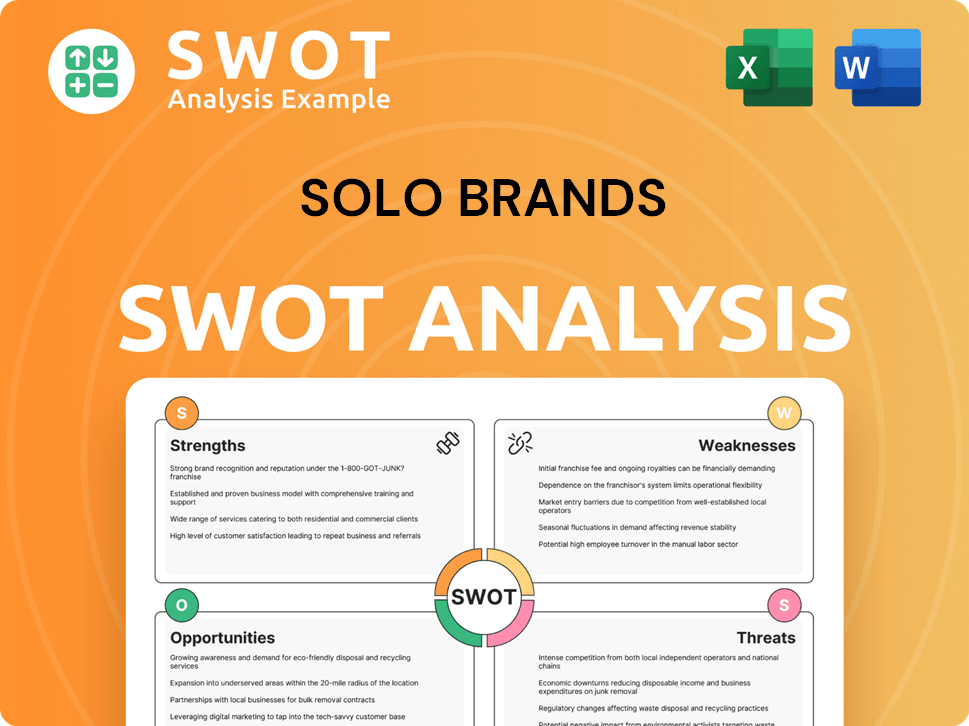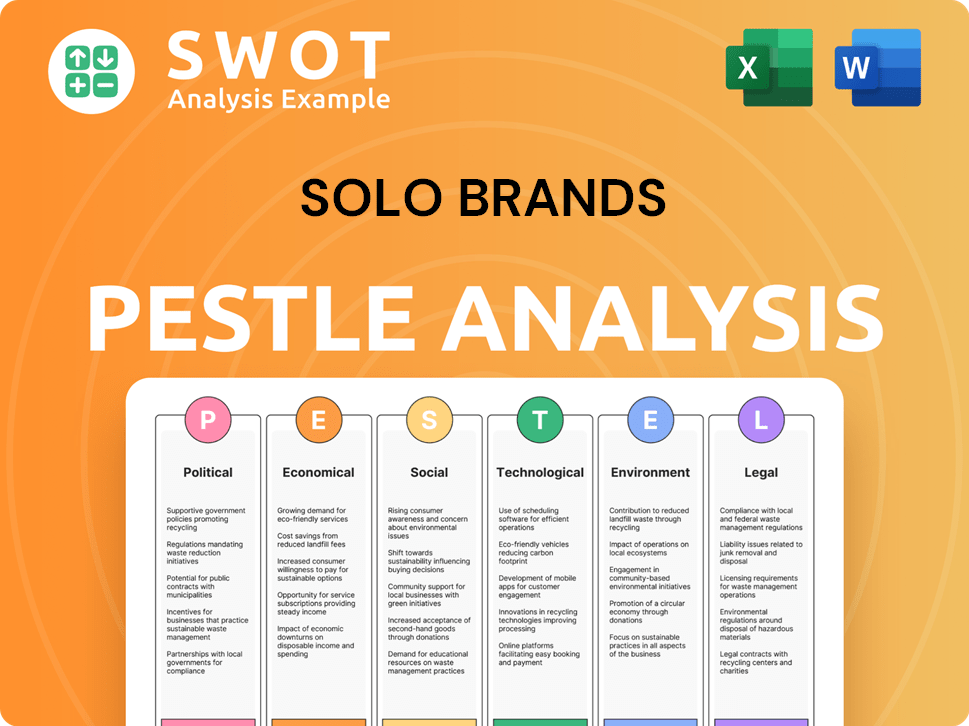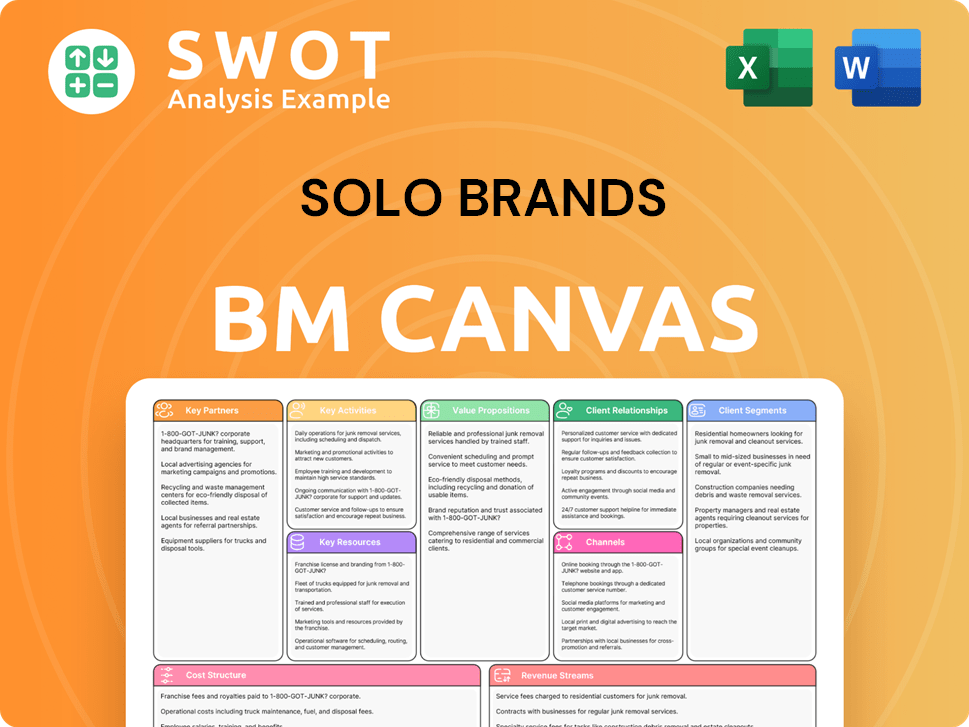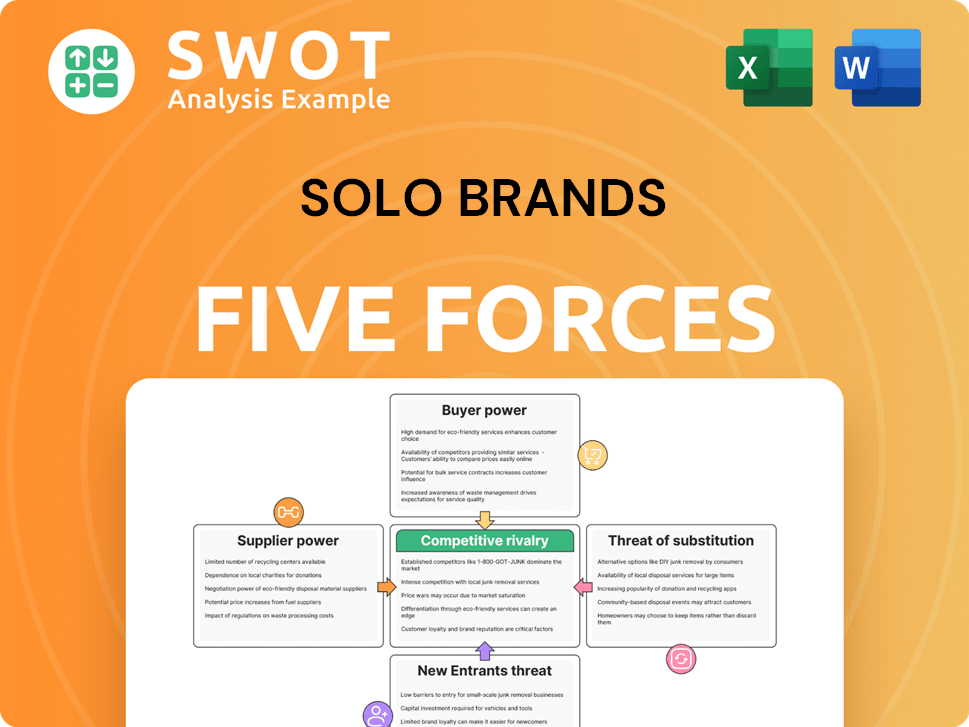Solo Brands Bundle
Who Buys from Solo Brands?
Understanding the Solo Brands SWOT Analysis is key to grasping its market position, but it all starts with the customer. What motivates the purchase decisions of those who choose fire pits, apparel, and watersports equipment from this direct-to-consumer powerhouse? This exploration dives deep into the Solo Brands target market and its evolution.

This analysis will dissect the customer demographics of Solo Brands, examining who they are, where they live, and what drives their purchasing behavior. From core outdoor enthusiasts to fans of casual apparel, we'll uncover the diverse segments that make up the company's consumer base. This comprehensive look will provide valuable insights into the company's target audience analysis and demographic segmentation strategies.
Who Are Solo Brands’s Main Customers?
Understanding the Customer demographics and Solo Brands target market is crucial for evaluating its performance. The company, which operates through a direct-to-consumer (DTC) model and retail partnerships, focuses on serving consumers (B2C). Its diverse brand portfolio includes Solo Stove, TerraFlame, Chubbies, ISLE, and Oru Kayak, each attracting different segments within the broader consumer market.
While specific demographic details are not publicly available, we can infer characteristics from the products offered and recent financial results. For instance, the Solo Stove segment, historically popular among outdoor enthusiasts, experienced a decline in net sales in late 2024 and early 2025. Conversely, the Chubbies segment demonstrated strong growth, with net sales increasing by 43.9% in the first quarter of 2025, indicating a shift in the Solo Brands consumer base and the importance of its apparel and activewear offerings.
The company's strategic focus in 2024 and 2025 includes initiatives like 'the Weekender' via DTC for Solo Stove and the integration of IcyBreeze to balance seasonal sales. This suggests a target audience that values outdoor activities and leisure. These strategies, along with the integration of Oru and ISLE, highlight the company's dynamic approach to target segments and its responsiveness to market trends and product performance. For more insights into the company's overall strategy, you can read about the Growth Strategy of Solo Brands.
The primary customer segments of Solo Brands are segmented based on lifestyle and product interests, which include outdoor enthusiasts, casual apparel consumers, and watersports lovers. The company's ability to adapt to market trends and optimize product offerings is crucial for sustained growth.
- Solo Stove: Primarily targets outdoor enthusiasts interested in fire pits, stoves, and related accessories. Sales were impacted by a lack of new product launches and changes in promotional strategies.
- Chubbies: Focuses on consumers interested in premium casual apparel and activewear. This segment showed strong growth, contributing significantly to overall revenue.
- ISLE and Oru Kayak: Cater to watersports enthusiasts. The company is optimizing these brands by combining them to enhance profitability.
- Target audience analysis: The company's strategy involves understanding the evolving needs and preferences of its customer base to tailor product offerings and marketing efforts effectively.
Solo Brands SWOT Analysis
- Complete SWOT Breakdown
- Fully Customizable
- Editable in Excel & Word
- Professional Formatting
- Investor-Ready Format

What Do Solo Brands’s Customers Want?
Understanding the customer needs and preferences is crucial for the success of Solo Brands. The company's customers are primarily driven by a desire for authentic outdoor experiences, convenience, and high-quality, innovative products. This focus allows Solo Brands to tailor its offerings to meet the specific needs of its target market.
For products like fire pits and camp stoves, customers are motivated by the aspiration for community building, ease of use, and portability. The introduction of new products like the Solo Steelfire™ 30 Stainless Griddle in June 2025 and the Solo Windchill 47 Cooler in May 2025 further demonstrates the company's commitment to catering to backyard chefs and enhancing outdoor comfort.
Solo Brands' approach involves a digital-first strategy, with 70.2% of sales in 2024 coming from direct-to-consumer channels. This allows the company to directly engage with its customers and understand their preferences. Customers value product performance, durability, and features that simplify or elevate their outdoor pursuits. Revenue Streams & Business Model of Solo Brands highlights how this customer-centric approach supports the company's business model.
The Solo Brands target market is driven by several key motivations. Understanding these factors helps in defining the Solo Brands target market and tailoring products to meet consumer needs.
- Authentic Outdoor Experiences: Customers seek products that enhance their connection with nature.
- Convenience: Products that are easy to use, portable, and simplify outdoor activities are highly valued.
- Community Building: Products like fire pits foster social interaction and shared experiences.
- High-Quality and Innovation: Customers appreciate durable, well-designed products that offer unique features.
- Enhanced Leisure Activities: Products are designed to improve the overall experience of outdoor living.
Solo Brands PESTLE Analysis
- Covers All 6 PESTLE Categories
- No Research Needed – Save Hours of Work
- Built by Experts, Trusted by Consultants
- Instant Download, Ready to Use
- 100% Editable, Fully Customizable

Where does Solo Brands operate?
The primary geographical market for Solo Brands is the United States, where the majority of its sales are concentrated. The company also has an international presence, with sales in Europe, Canada, and Australia. Understanding the geographical distribution of their customer base is key to effective marketing and sales strategies.
Solo Brands' international sales, primarily from the Solo Stove segment, were approximately $5.6 million for the three months ended March 31, 2025. This is a slight decrease from $5.8 million in the same period in 2024. This data indicates a relatively stable, yet smaller, international market compared to the U.S.
The company's approach to distribution includes e-commerce and strategic retail relationships, suggesting an adaptable model for different markets. To learn more about the company, you can read Owners & Shareholders of Solo Brands.
The United States remains the core market for Solo Brands. The company's strategies and product offerings are primarily tailored to the U.S. consumer base. This focus allows for a deeper understanding of the Solo Brands target market within this region.
Solo Brands is expanding its reach into international markets, including Europe, Canada, and Australia. This expansion is supported by an omnichannel approach. The company is working to understand the customer demographics and preferences in these markets.
The company adapts its strategies to suit various markets. This includes tailoring marketing campaigns and potentially offering localized products. The goal is to meet the specific needs and preferences of the Solo Brands consumer in each region.
Solo Brands is adjusting its supply chain to address tariff impacts. This involves shifting production to alternative countries. These adjustments could affect the company's presence in certain markets and its ability to serve its target audience analysis.
Solo Brands Business Model Canvas
- Complete 9-Block Business Model Canvas
- Effortlessly Communicate Your Business Strategy
- Investor-Ready BMC Format
- 100% Editable and Customizable
- Clear and Structured Layout

How Does Solo Brands Win & Keep Customers?
Customer acquisition and retention are critical strategies for the success of any brand, and the same applies to Solo Brands. The company has built its business around a direct-to-consumer (DTC) model, which allows for a more personalized approach to customer engagement and marketing. In 2024, a significant portion of its sales, specifically 70.2%, came from DTC channels, highlighting the importance of this strategy.
Solo Brands focuses on building passionate communities of loyal, high-value customers. This approach involves a multi-faceted strategy that includes digital advertising, social media engagement, and potential influencer and referral programs. The company is also expanding its physical retail presence, with plans to grow its existing stores, demonstrating a commitment to an omnichannel sales model.
Retention strategies are crucial, especially given that customer acquisition costs can be high, sometimes up to seven times more than retention efforts. Solo Brands aims to turn one-time buyers into lifelong customers by delivering new, innovative products and providing a differentiated experience. This focus on customer lifetime value is evident in the company's initiatives.
The direct-to-consumer (DTC) channel is a cornerstone of Solo Brands' strategy. This channel accounted for 70.2% of total sales in 2024. This allows for direct interaction with customers, facilitating targeted marketing and personalized experiences.
While DTC is central, Solo Brands also operates physical retail stores. The company currently has twelve Chubbies retail stores and one ISLE surf pro-shop. Expansion plans indicate a move towards an omnichannel model, providing customers with multiple points of contact.
Solo Brands employs various marketing channels, including digital advertising and social media. The company appointed PMG as its media Agency of Record for Solo Stove in March 2024 to improve marketing effectiveness and increase demand. This includes building pricing strategies to align channels.
Retention is a key focus, with efforts aimed at converting one-time purchasers into loyal customers. The company is investing in product innovation to expand its total addressable market. The success of the Chubbies segment highlights the importance of community building.
The company's marketing and media strategy is evolving, with a focus on improving marketing effectiveness. The shift away from extensive discounting in the Solo Stove DTC channel is part of a broader effort to realign go-to-market strategies and improve profitability. Understanding the Brief History of Solo Brands can provide further context on its evolution and strategic shifts.
Digital advertising is a key component of Solo Brands' customer acquisition strategy. This includes targeted campaigns on platforms where the target audience spends their time.
Social media plays a crucial role in building brand awareness and engaging with the target audience. The company likely uses various platforms to interact with potential and existing customers.
Influencer marketing is a potential acquisition channel, with Solo Brands partnering with relevant influencers to reach a wider audience. This helps to build brand credibility.
Referral programs can incentivize existing customers to recommend products to their networks. This is a cost-effective way to acquire new customers.
Solo Brands focuses on building communities around its products. This builds loyalty and encourages repeat purchases. This is a part of understanding the Solo Brands consumer.
Continuous product innovation is key to retaining customers and expanding the market. The company is investing in a multi-year consumer-led product innovation pipeline.
Solo Brands Porter's Five Forces Analysis
- Covers All 5 Competitive Forces in Detail
- Structured for Consultants, Students, and Founders
- 100% Editable in Microsoft Word & Excel
- Instant Digital Download – Use Immediately
- Compatible with Mac & PC – Fully Unlocked

Related Blogs
- What are Mission Vision & Core Values of Solo Brands Company?
- What is Competitive Landscape of Solo Brands Company?
- What is Growth Strategy and Future Prospects of Solo Brands Company?
- How Does Solo Brands Company Work?
- What is Sales and Marketing Strategy of Solo Brands Company?
- What is Brief History of Solo Brands Company?
- Who Owns Solo Brands Company?
Disclaimer
All information, articles, and product details provided on this website are for general informational and educational purposes only. We do not claim any ownership over, nor do we intend to infringe upon, any trademarks, copyrights, logos, brand names, or other intellectual property mentioned or depicted on this site. Such intellectual property remains the property of its respective owners, and any references here are made solely for identification or informational purposes, without implying any affiliation, endorsement, or partnership.
We make no representations or warranties, express or implied, regarding the accuracy, completeness, or suitability of any content or products presented. Nothing on this website should be construed as legal, tax, investment, financial, medical, or other professional advice. In addition, no part of this site—including articles or product references—constitutes a solicitation, recommendation, endorsement, advertisement, or offer to buy or sell any securities, franchises, or other financial instruments, particularly in jurisdictions where such activity would be unlawful.
All content is of a general nature and may not address the specific circumstances of any individual or entity. It is not a substitute for professional advice or services. Any actions you take based on the information provided here are strictly at your own risk. You accept full responsibility for any decisions or outcomes arising from your use of this website and agree to release us from any liability in connection with your use of, or reliance upon, the content or products found herein.